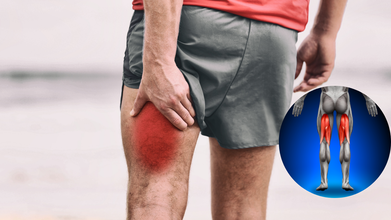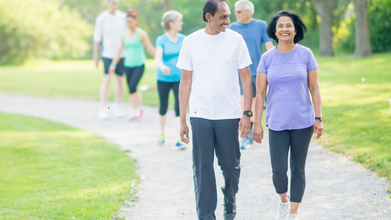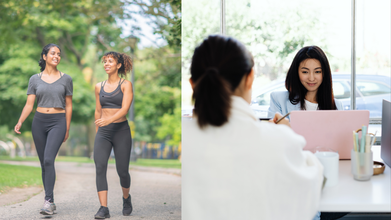- Health Conditions A-Z
- Health & Wellness
- Nutrition
- Fitness
- Health News
- Ayurveda
- Videos
- Medicine A-Z
- Parenting
Fact Check: Do Stronger Thigh Muscles Really Mean That You Live Longer?

Credits: Canva
Thanks to social media, now every one is a fitness influencer. However, not everything people say on social media is true, nevertheless social media did benefit many, allowing easy access on health and fitness. But whatever we see on the platform must be always taken with a pinch of salt.
One such video which is trending is of actor Ram Kapoor, who once was 140kg and then went on to lose 55kgs in 18 months. He has, ever since become an inspiration for many to lose weight naturally. As per him, having two simple meals a day and intermittent fasting principles helped him. Now, as somebody who influence people achieving their own fitness goals, especially that he himself has experienced it, he does not shy away from talking about it.
Also Read: Is Huntington’s Disease Genetic? Here’s Everything You Should Know
In one such conversation, he reveals that people in the insurance industry hire insurance experts to predict the age of a person and when he is going to die. One such man is Gary Brecka, a human biologist, and expert in science of human performance. Kapoor says, "He has an 82% accurate record in predicting one's longevity, based on the last 5 years of their life history."
Kapoor also notes that now he uses this experience he has gained from insurance industry to help people lead a better and healthy life.
"Do you know how he correlates the age till one will live?" Kapoor asks, "Through your thigh muscles."
Kapoor says that the stronger your thigh muscle is, the longer you will live. "When you sit, you need this muscle to get up. In India, everyone makes an upper body, but you do not need biceps to stand up," he said.
"Secondly, when you are 80 years old, it is very easy to trip and fall and if your leg muscles are not strong, you will have to have a hip replacement surgery, which is the beginning of the end. The person who underwent that surgery could only live for 5 to 6 years more."
Are Thighs Really The Key Predictor Of Longevity?
This is not the first time someone is talking about how thighs can help someone predict their age of living. Simon Sinek, an American author, international speaker, and more, also seconds this theory.
"Historically, thighs are the most important muscle responsible for notion." However, he correlates it with friendship. He says before cars, if you had to go meet a friend you would take a train or walk, which will put your thigh muscles at work, this means you have friends and to meet them you are mobile, "which means you are more likely to live longer".
Is There Any Truth In This?
While stronger thigh muscles could be one of the key predictors, the reason is not because it means you have a friendship or that a hip replacement surgery would only let you live 5 to 6 years afterwards.
As per the Harvard Health Publishing, researchers found that people with big thighs had a lower risk of heart diseases and premature death than those with thick thighs.
Also Read: What Does Trump's Latest Health Checkup Reveal About Him?
The real reason is because stronger thigh muscles, or leg muscles reduce risk of all cause and heart-relate mortality. In men, specifically, it could predict the age for how long do they live, notes a 2011 study published in Author Manuscript. Strong thighs improve stability, reduce risk of falls. This also supports daily functional activities, which seems to have reduced as age progresses. Also subcutaneous fat in thighs can provide protective effects for bone and bone strength and cardiovascular health, also notes Dr Kunal Sood, MD, and double board certified anesthesiology and international pain medicine, based in Maryland, US.
Note: The information in this article is based solely on observations and insights from the referenced videos. It does not, in any way, claim to define or predict a specific lifespan for anyone.
How Post Malone Lost 55lbs Just By Cutting Soda And Ditching Junk

Credits: Canva
"I'm excited for this next chapter in my life, I'm the happiest I've ever been, and for since I could remember I was sad," said Post Malone as he talked about his journey of losing 55 pounds. He went from 240 lbs to 185 lbs, he revealed at The Joe Rogan Experience Podcast. His inspiration? His daughter. He said that he is focused more on his health since becoming a father.
"It is definitely made me take better care of myself. I want to be around to see her go and do kick-*ss stuff. And before, you know, I was really drinking a lot and smoking a lot and stuff. I kind of took everything and toned it down a little bit and, you know, doing my best and really got my weight going," he said.
His weight loss journey started after he welcomed his daughter in May 2022, and on April 20233, he shared on his Instagram that post becoming a father he is now prioritizing his health.
How Did Post Malone Lose So Much Weight?
He said it is simple, he decided to "kick soda and start eating better". He also is trying to cut down his smokes and brews or give up completely, which is taking time.
On his Instagram post, he wrote: "I've had a lot of people ask me about my weight loss and I'd suppose, performance on stage. I'm having a lot of fun performing, and have never felt healthier. I guess dad life kicked in and I decided to kick soda and start eating better so I can be around for a long time for this little angel. Next up is smokes and brews, but I like to consider myself a patient man... lol!"
While his fans were initially concerned about his weight loss, he reassured them that his "brain is in a super dope place" and he was "the happiest" he has ever been in a long time.
When he made his appearance in June 2024, on The Joe Rogan Experience Podcast, he said that his fans in fact, thought, that he started using drugs, due to his drastic weight loss. This is why he posted on Instagram to deny those allegations. “I remember, whenever I started losing my weight, everybody was like, ‘Hey, this is what meth looks like,’ and I started dancing on stage and having fun and having more energy and just enjoying life again, you know what I mean,” he told host Joe Rogan. “Like I mentioned, I was s***** for a long time, but I had my baby and I’m in a great f****** spot and then the first thing that happens is like, ‘Oh he’s on f****** drugs.’"
However, Malone has confirmed that he is not "any hard drugs".
What Helped Malone Lose 55 Pounds?
In an appearance on The Howard Stern Show in October 2023, Malone said that he has not been on weight loss medication, rather he is now making better food choices.
Earlier, whenever he was on tour, he would go for junk, but now, he has made a deliberate choice to eat "grilled chicken" "carrots" with a "little bit of white rice with hot sauce". He said he was blown away to find out that hot sauce has no calories.
He also shared that he has cut out fried food and pizza. He shared that he would previously eat a lot of junk while on tour, especially because those places were open at 2 am after a show. However, when he made those small dietary changes, he lost 20 pounds, which made him think "let's keep building".
He also shared that he started cutting down on his soda intake. However, he would occasionally reward himself with one after a show.
He also showed off his weight loss in an August 2023 Instagram post on a mirror selfie and wrote: "Introducing Viceroy Chungus VonBattlepass, i love you," in caption.
Cannot Hit 10,000 Steps A Day? A Short Stroll Too Could Make You Healthy

Credits: Canva
For years, the idea of walking 10,000 steps a day has been treated like universal fitness wisdom, however, a recent study reveals that even a short stroll too could help you stay healthy.
From fitness trackers to morning-walk groups, the number has been repeated so often that many people believe it is a scientifically proven rule. The truth is far simpler and far more encouraging. New research shows that you do not need anywhere near 10,000 steps to improve your health. In fact, even a small amount of regular movement can dramatically lower your risk of heart disease and early death.
What Recent Research Reveals
A new study published in the British Journal of Sports Medicine examined how step counts influence longevity and heart health, particularly in older adults. The findings were surprisingly optimistic. Scientists discovered that walking as few as 4,000 steps in a day, even if you manage this number only one or two days a week, can reduce the risk of death by 26 percent. It can also lower the risk of heart disease by 27 percent when compared to those who barely moved.
The benefits became even more striking when participants achieved the 4,000 step target on more than three days per week. In that group, mortality dropped by more than 40 percent and the risk of heart issues fell by 27 percent. These numbers show that moderate, regular walking has powerful protective effects on long-term health.
How Many Steps Do You Really Need
The study also explored whether aiming for higher step counts brings additional benefits. Researchers found that walking around 7,000 steps a day provides a slight extra advantage when it comes to living longer. However, it does not significantly change cardiovascular outcomes. This means that hitting 4,000 steps is already enough for meaningful protection, especially for older adults or people who are unable to reach higher counts.
Interestingly, the study also revealed that the number of days you walk matters far less than the total steps collected throughout the day. When scientists adjusted for total daily steps, the link between how many days people walked and their health results disappeared. The real takeaway is this: what matters most is how much you move overall, not whether you meet a daily or weekly quota.
Why Consistency Matters More Than Intensity
Walking is one of the simplest forms of movement, yet its benefits are remarkably wide-ranging. It is gentle, low impact and accessible to almost everyone. Regular brisk walking has been shown to improve heart health, support weight management, boost mental well-being and improve mobility. These improvements occur because consistency helps the body adapt, even when the total effort seems small.
For older adults, or for anyone returning to activity after a long pause, this consistency is especially important. Small, steady efforts accumulate and gradually build up stamina. Over time, this reduces the risk of chronic disease and enhances overall fitness without stressing the joints.
Tips To Make Walking A Sustainable Habit
If you want to enjoy the health benefits of walking, the key is to stay consistent rather than chase big numbers. A few practical tips can help you build a routine that feels realistic and enjoyable.
Start slowly
If you have been inactive for a while, begin with five to ten minutes of walking at a comfortable pace. Gradually increase your duration and distance over several weeks. This prevents strain and reduces the risk of giving up too soon.
Set achievable goals
Aim for manageable targets such as walking 20 to 40 minutes three days a week. Once this feels comfortable, you can add more time or increase your frequency if you wish.
Adjust your routine when life gets busy
If you are traveling or have long work hours, try breaking your walks into shorter chunks. A few five to ten minute walks throughout the day can help you stay on track.
Do not let the weather stop you
When outdoor conditions are not ideal, choose indoor spaces such as malls, gyms, community centers or even long corridors at home or work.
Add variety to your routes
Different routes help fight monotony and make walking more enjoyable. Rotate between parks, neighborhoods or indoor spaces to keep things fresh.
10,000 Steps Cannot Undo The Damage Caused By A 9-Hour Desk Job, According To Doctor

Credits: Canva
For many people, completing a daily step goal feels like a sign of an active lifestyle. Fitness trackers, wellness challenges and social media trends have popularized the belief that 10,000 steps can undo the negative effects of long hours spent at a desk. However, vascular experts warn that this assumption is misleading. Prolonged sitting continues to damage the veins and circulation even if one walks later in the day.
Vascular Surgeon and Varicose Vein Specialist Dr Sumit Kapadia recently posted a video on his Instagram channel explaining why step counts alone cannot protect vascular health. He said this is something he tells his patients almost every day. Even if someone completes their step goal in the evening, the body has already endured hours of immobility that strain the veins.
According to Dr Kapadia, circulation does not depend on how much a person walks in total. Instead, it depends on how frequently they move. Long stretches of sitting from nine in the morning to seven in the evening cause blood to stagnate in the legs. This stagnation triggers a progressive cycle: vein valve weakness, swelling, varicose veins and, over time, an increased risk of developing blood clots.
Why Sitting for Long Hours Harms the Veins
When a person sits for too long, blood flow in the legs slows down. Veins must work harder to pump blood upward toward the heart, especially against gravity. The longer blood pools in the lower legs, the more pressure builds inside the veins. Over time, this weakens the valves that keep blood moving in the right direction.
Dr Kapadia explained that even a healthy step count cannot reverse ten hours of immobility. The veins experience stress and pressure throughout the day, and walking later does not undo the hours of stagnation already endured.
People with sedentary jobs, long commutes or limited movement throughout the day are especially at risk. Additional factors like being overweight, having a family history of venous disease, or standing for long hours without moving can worsen the impact.
Movement Frequency Matters More Than Step Count
According to Dr Kapadia, vascular health depends more on how often you move than how much you walk. The solution is not long-distance jogging or intense workouts after work, but small, consistent breaks during the day.
He offered a simple rule for preventing vein damage:
- Get up every 45 to 60 minutes.
- Stretch briefly to activate muscles.
- Walk for at least two minutes.
- Move your calf muscles, which act as the body’s “peripheral heart.”
Calf muscles play a major role in circulating blood back to the heart. When they contract, they push blood upward from the legs. But when they remain still for long periods, this pumping mechanism weakens. Small actions like ankle rotations, standing on tiptoes or short hallway walks can activate this pump and support vein health.
Small Breaks Make a Big Difference
Dr Kapadia emphasized that the veins do not need marathons. They need movement. Tiny breaks spread across the day help prevent swelling, heaviness, varicose veins and long-term complications such as deep vein thrombosis.
In a world where work, travel and digital life keep people sitting for most of the day, this message is more relevant than ever. Steps matter, but frequency matters far more. The key to healthy veins is simple: move often.
© 2024 Bennett, Coleman & Company Limited

